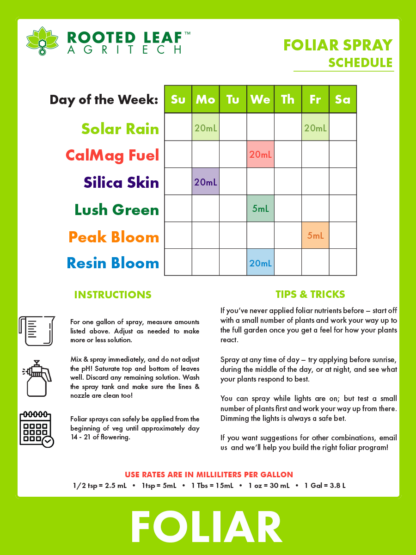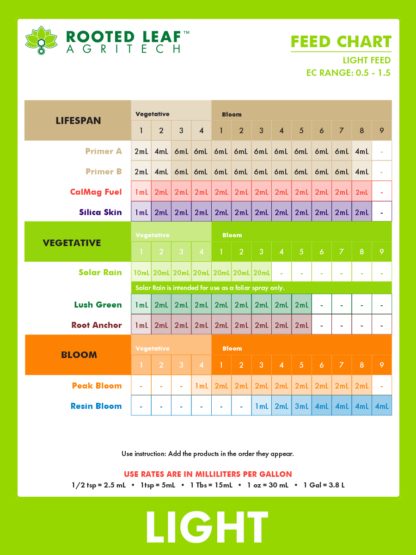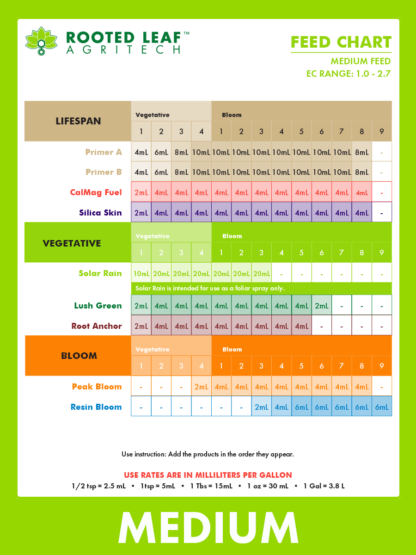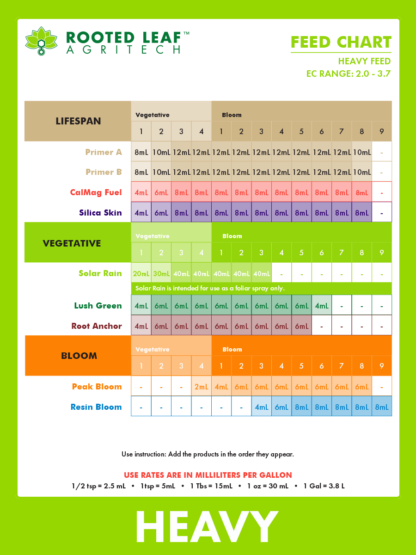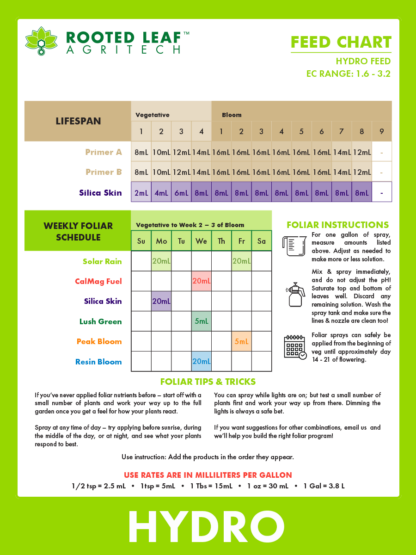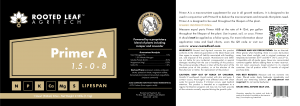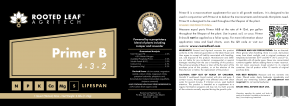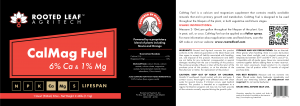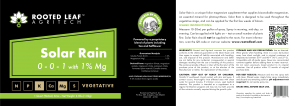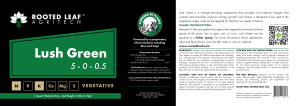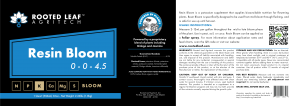Resources
What are Carbon-Based Fertilizers?
Product Line Overview
LIFESPAN
Our Lifespan products are used across the full life of the plant. They contain balanced proportions of macro and micronutrients that are 100% bioavailable to plants and deliver a dependable source of nutrition in both the vegetative and flowering phases.

Primer A&B
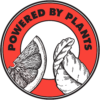
CalMag Fuel

Silica Skin
VEGETATIVE
Our Vegetative products contain everything plants need for strong root establishment and development, plus all of the building blocks that help plants develop lush green canopies in high-intensity growing environments. Our Vegetative products are 100% free of nitrate and phosphate salts.

Solar Rain

Root Anchor

Lush Green
BLOOM
Our Bloom products nourish even the fastest growing and highest yielding plants. They are fine-tuned to deliver all of the necessary building blocks for large, dense flowers and the highest quality yields. Our Bloom products are 100% free of nitrate and phosphate salts.

Peak Bloom

Resin Bloom
Foliar Sprays
The following products are excellent foliar sprays and can be safely applied up to approximately week 2 or 3 of flowering:

Solar Rain
(10 – 20mL/gal)

Silica Skin
(10 – 20mL/gal)

Lush Green
(5 – 10mL/gal)

CalMag Fuel
(10 – 20mL/gal)

Peak Bloom
(2.5 – 5mL/gal)

Resin Bloom
(10 – 20mL/gal)

Solar Rain
(10-20mL/G)

CalMag Fuel
(10-20mL/G)

Silica Skin
(10-20mL/G)

Lush Green
(10-20mL/G)

Peak Bloom
(5-10mL/G)

Resin Bloom
(10-20mL/G)
- Within 6 hours of mixing products into water, use the entire mixture.
- We recommend foliar mixtures of no more than 2-3 products.
- Spray early in the morning, and keep a consistent schedule.
- Clean your sprayer line out with fresh water after each application.
Labels
Frequently Asked Questions
We recommend following the order shown on our feed chart.
If you are new to our products, start by perform a simple jar test – grab a gallon jug of water, and make some feedwater, adding the products slowly once at a time and agitating gently between addition of products. It doesn’t really matter which week of the feed chart you pick, but we suggest one of the stronger feeds, as this will give you a better understanding of what your pH and EC will be like when you feed the plants, while also letting you determine any incompatibilities.
As you work your way through the product line, you want to look for any solids that form or clumps that coagulate together. If the feedwater looks clear at the end, as it should, you’re good to go!
Generally speaking, and in most cases: yes, it is safe to add CalMag Fuel and Silica Skin into the same reservoir, and no you don’t need to add Silica Skin first.
If you are starting with less-than-ideal water, or simply concerned about the chemistry of your water, we suggest adding Silica Skin last to avoid any problems that might arise.
Primer A&B along with Silica Skin are stable in hydroponic and recirculating systems, and can be kept for several days as needed. When used in conjunction with the rest of the Rooted Leaf product line, feedwater should not be kept for more than 24 hours.
Regardless of what fertilizer line you use, it will always be in your best interest to keep everything clean, so make sure you clean your lines, tanks, and even measuring cups often!
Be fancy – swirl gently, don’t shake. It’s a good idea to agitate when possible to make sure everything is homogenized.
Unless you’re handling Root Anchor – in which case, we suggest you shake gently! Although we filter everything through a 70 micron screen, the individual filtered particles like to come together and settle out on the bottom. A gentle shake with some swirling is all you need to bring that organic-rich layer of soil-boosting goodness into every drop you measure out.
Get your water around 65*F (18*C or 291.8 Kelvin) if you can – but try not to go higher than that, and don’t dip below 55*F (13*C or 285.9 Kelvin) otherwise you will notice your soil stays wet for longer and your plants grow more slowly for however long it takes that water to raise up to about 68*F, which we’ve come to think is pretty dang optimum for the whole nutrient uptake thing plants do.
Yes, all of our inputs are individually tested for heavy metals, and then our finished products are analyzed to high standards as well.
We are headquartered in Washington State which has some of the strictest requirements in the nation, and we pass all of the requirements for heavy metal concentrations.
We exceed expectations for sea plants in particular. The sea plants we source are food-grade and therefore of the highest quality possible to purchase anywhere in the world. Not many fertilizer manufacturers can say that, and we are proud to be able to.
The cost of our fertilizer can be paid for several times over by the increase in yield & quality you could get over a traditional/organic or a conventional/salt-based program, assuming all other variables are properly dialed in.
The most valuable crops in the world are defined by the amount of carbon they managed to convert into whatever desirable substances they produce – whether its cannabis/hemp, hops, grapes, apples, etc. – they all increase in market value as a result of getting more carbon in the right forms.
In the context of cannabis/hemp, salt-based fertilizer programs cost less but require the use of sealed flowering rooms with high concentrations of CO2 in the air to keep the carbon load high. In extreme examples, the concentration of CO2 may be close to 5 times higher than normal atmospheric levels.
The tubs of salt may appear cheaper, but you will end up paying for the carbon starting with the cost of build-out and never ending with the monthly electricity bills which – we would argue – are a lot more expensive than our carbon-based fertilizers.
Oh, and we forgot to mention, our carbon-based fertilizers are capable of delivering more carbon to the plants than 3,000ppm of CO2 does.
You should try every product at least once – everything we make fits a very specific need that can arise during the lifespan of a plant, and so even if you don’t follow our recommended rates, you will find tremendous benefit from tailoring it to your needs or simply using it as a foliar spray. Our products as foliar sprays = incredible.
You will see the most benefits of a carbon-based approach to plant nutrition when the whole system is put together. The products are designed to work with each other, and have good synergistic chemistry with each other.
We cannot guarantee that mixing product lines will not result in some adverse chemical reactions, but generally speaking, we have not experienced any issues when mixing our products with others … except a decrease in overall plant performance. They just want more carbon!
Our full product line is designed to transform inert mediums into living soils that can be reused over and over again while participating in the types of high-intensity nutrient cycles that are required for the best crop performance the world has ever seen.
If you are starting with an inert medium, such as a high quality peat/perlite blend, it would be a good idea to start with our full line right away – head on over to our Resources page to find a feed chart that best fits your needs!
If you are starting with a medium which contains sources of NPK or CalMag, you should consider adding Root Anchor and CalMag Fuel as those will accelerate the conversion of whatever nutrients are in the soil, into plant-available forms that help young plants establish quickly and grow rapidly. After a couple of weeks, depending on plant performance, consider adding Primer A&B and the rest of our product line at full strength.
You can buy our products on our website, and if you want your local retailer to carry our line, just follow these two simple steps:
First – ask them to carry our product line and let them know you’ll tell your friends to try our magic sauce too. That always helps!
Second – send us an email and let us know which store you asked to carry our products! We will follow up with them and check back in with you.
Thank you for your support!
Our approach to plant nutrition is fundamentally different because our product line is based on carbon chemistry, while the rest of the agricultural industry can generally be put into either natural/organic or conventional/salt based.
We developed our own manufacturing processes from scratch, modeled after the soil-building and plant-growing chemistries that have nourished this green planet for billions of years.
We do things much differently than other fertilizer manufacturing companies, who may not have even heard of the ingredients we source, let alone understand their benefits.
Carbon-based fertilizers deliver massive performance benefits over natural/organic and conventional/salt based counterparts – both in the context of plant performance and in soil/microbial health. The reason for this is simple: carbon is the most important element for a plant, and pretty much all plant metabolic activity revolves around capturing carbon, utilizing it, or storing it in some way.
So if your nutrient line is not carbon-based, you’re using outdated and inefficient technology!
Natural/organic inputs are traditional ingredients with long-standing histories of use in agriculture around the world – limestone, manures, composts, crushed rocks, etc. – generally speaking these ingredients require more time to break down in soils as they participate in natural nutrient cycling processes which are mediated by biological activity in the soil.
Conventional/salt based fertilizers are more recent developments of industrial chemistry. These are typically inorganic compounds created from a chemical reaction that combines two oppositely charged elements – such as potassium and phosphorus – to make salts – such as potassium phosphates – which are then precisely dehydrated, bagged up, and sold around the world.
Natural/organic inputs typically contain carbon, but they are not considered carbon-based fertilizers as there are significant structural and functional differences in those carbon molecules. They have much lower amounts of stored energy and therefore require greater energy expenditure to metabolize.
Conventional/salt based fertilizers generally contain little to no carbon, and are only focused on supplementing two dozen or so elements that are essential for plant life. These forms of elements can quickly throw plants out of balance with carbon.
The overuse of both natural/organic and conventional/salt based fertilizers can lead to diminished plant health and can even result in the total destruction of soil biology and profound, detrimental shifts in soil chemistry.
Do not adjust the pH of our feedwater! You will oxidize our chelates and break the chemistry down that we have worked so hard to achieve.
There is no need to adjust the pH of our products – which should come out fairly acidic – because they are buffered to deliver elements in soluble forms across the full pH range that the plants are capable of growing in.
The rhizosphere – that small space just outside the root hairs that collectively makes up an enormously complex ecosystem of plants, microbes, fungi, and hopefully not less-desirable organisms – is naturally very acidic. In healthy soils that have good physical and chemical properties, plants and their companion microbes/fungi release acidic substances into the soil, which guides the conversion of insoluble forms of nutrition into soluble forms as root hairs grow through soils in search of water and minerals.
Our products should come out fairly acidic because they too contain a suite of organic acids which are utilized for the very same purpose of increasing nutrient availability to plants. These organic acids are built-in salt-scrubbers that detoxify the soil at the same time they optimize it and keep it conditioned for healthy plant and microbial activity!
While many of our products are 100% natural and compliant with NOP requirements, we currently do not have any products registered as organic.
All of the plants we source are organic and/or sustainably harvested in their native regions by farmers and stewards of the land who have cultivated, and been cultivated by, these plants for generations.
We take great pride in sourcing the cleanest naturally occurring minerals that are organic, food, and/or pharmaceutical grade. We do not source any merchant or technical grade inputs, and only work with suppliers whose manufacturing processes we are familiar with.
Whenever and wherever possible, we work with local and US-based companies to source our ingredients and build our relationships with farmers.
Nope, and they never will. Our product line is built out of plants, natural minerals, and advanced carbon chemistries that provide naturally occurring compounds in their most ideal & optimized forms – those which are native to plant physiology.
Arguably, potassium regulates carbon metabolism more than any other element in plants, and we have learned from our experiences that a carbon-based nutrient program requires elevated levels of potassium to help create balance within the plants as they grow rapidly.
For a more in-depth explanation please see our article about potassium as a macronutrient in plants.
Primer A&B contain plenty of calcium and magnesium; and as a standalone source of nutrition, they deliver a balanced and bioavailable blend of all macro and micronutrients needed across the lifespan of the plant, however there are some key benefits to our CalMag Fuel and a few differences that are worth mentioning.
CalMag Fuel was the first of its kind on the market and continues to be the best – it is like rocket fuel for plants. The reason for this is because there are massive amounts of chemical energy stored in reduced forms of carbon – like the ones our chelates and complexes are made out of.
Our chelates and complexes are native to primary metabolic pathways in plants – they require little to no energy expenditure to access and provide significant net gains in energy, which translate to improved growth and performance across the full lifespan of the plant.
CalMag Fuel has a 6 to 1 ratio of calcium to magnesium whereas Primer A&B have a 4 to 1 ratio of calcium to magnesium. This allows us to keep calcium levels high while reducing overall magnesium and nitrogen loads towards the middle to late stages of flowering. Many growers are looking for nitrate-free calcium supplements and CalMag Fuel is exactly what their oh so sweet dreams are made of.


